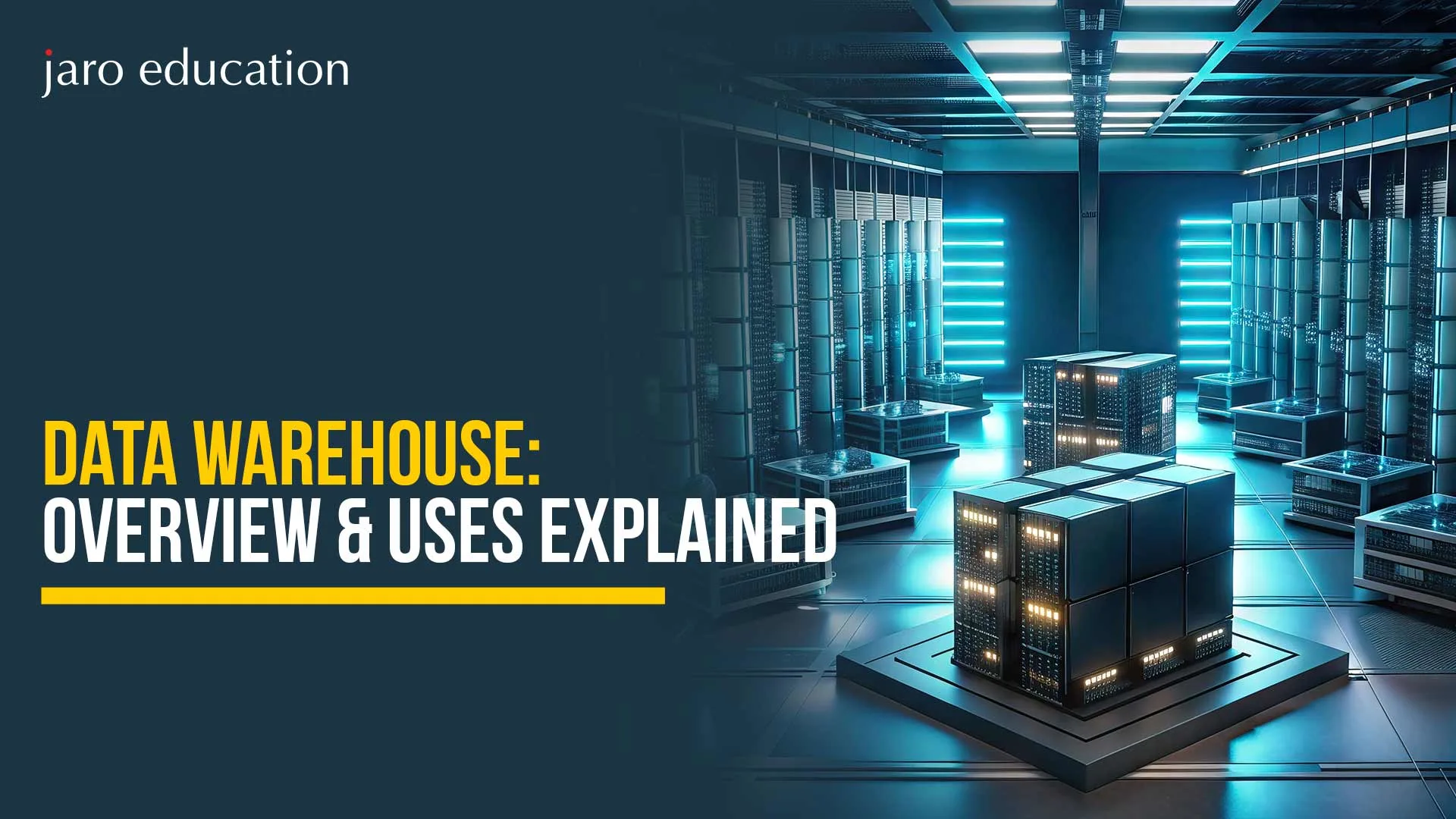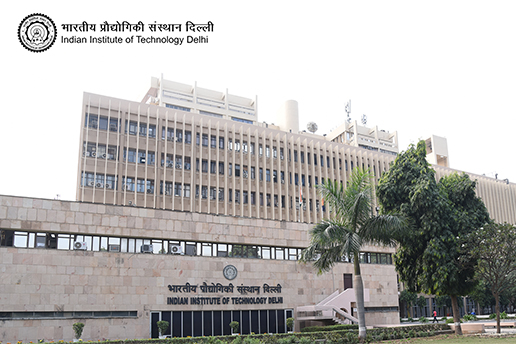Data Warehouse: Overview & Uses Explained
Table of Contents

Are you working in a data-driven organisation? If yes, you must have realised that large volumes of data are generated every minute, hour, or day. Where do all these data go? How are they stored? Where are they stored? These are some of the most intriguing questions that need to be understood. Let us simplify them for you.
All the petabytes of data generated in daily organisational systems are integrated and stored in a shared platform called a data warehouse. It stores and processes a vast amount of data from various sources. This also helps companies make informed decisions by using data analytics on large volumes of information.
If you want to learn more about what data warehouses are, how they work, and their architecture, this blog is your go-to guide. Stay tuned till the end of the blog to get relevant information that can also help you to explore a career in data today.
What is a Data Warehouse?
A data warehouse is the secure electronic storage of information by any organisation. The main purpose of data warehouses is to create a pile of historical data that can be further used and analysed to get useful insights into the company’s daily operations. A data warehouse is one of the most crucial elements of business intelligence.
Data warehouses store current and historical data together and act as the single source of truth for an organisation. The data moves into a data warehouse from operational systems like CRM and ERP, databases, and external sources such as IoT(Internet of Things) devices. In fact, the innovation of cloud computing has brought a major transformation in the sector. Today, most of the data storage locations have moved from traditional in-house infrastructure to different locations, such as public and private clouds.
In addition, modern data warehouses are mainly designed to store all types of structured and unstructured data, such as image files, sensor data, videos, and more. In summary, for an organisation working on data without data warehousing, it becomes difficult to combine data from heterogeneous sources and get a long-term view of data at different times.
*sap.com
What Are Data Warehouses Used For?
A data warehouse is one of the crucial components that are mainly used to interpret and analyse different types of data used in a business in a non-production environment. By using a data warehouse, an organisation can record its transactions and support the business by discovering patterns, outliers, trends, and many other critical relationships between the data that are developed over time.
There are many advantages of a data warehouse. It protects the integrity of a company’s data by assisting business owners in querying it without changing or disturbing the production environment in any way.
When to Use a Data Warehouse
While there are a multitude of reasons to use a data warehouse, the four reasons given below stand out the best:
- If you want to analyse data from different locations, if you want to track down the activity of your most important clients, you may want to combine payment information from your credit card processor.
This becomes much easier when data from all the sources can be stored and altered at one single location. - Want to discretize your analytical data from transactional data.
For instance, you may want to collect and analyze data from a production application’s activity logs, but you do not want to disrupt the business functions. This is where one can use a data warehouse by automatically sending the data that’s designed for complicated querying and working on it there. - Want to speed up your queries?
When you store your transactional data in summary tables for more efficient use, you can use a data warehouse to query it much faster.
Concepts of Data Warehouse
Let’s understand the data warehouse concepts in the simplest way:
- Basic Data Warehouse: A basic data warehouse means you can reduce the total amount of data stored in a system. It is mainly done by eliminating redundancy in the information and making it look simpler and clearer. As these data warehouse concepts work by combining information from various sources, different departments can directly access data from the warehouse without wasting time going through multiple folders.
- Data Warehouse with Staging Area: There are other data warehouses that perform the cleansing process before storing data. These systems consist of “staging areas” where information is first reviewed and evaluated, then moved to the warehouse. This concept allows you to only get reliable data from the warehouse. It is mainly used by businesses that want to process a large volume of data to filter irrelevant information.
- Data Warehouse with Data Marts: Data marts help to improve the data warehouse’s customisation level. In these data warehouse concepts, once the data is moved for processing, data marts help to streamline information to employees. The benefit of this concept is that it allows multiple departments to enhance productivity as they do not have to waste time waiting to get the information from other departments.
Data Warehouse Architecture
There was a time when data warehouses used to function in layers that exactly matched the flow of the business data presentation of data warehouse architecture, but today’s type of warehouse is mainly divided into three layers and also combines OLTP and OLAP in a single system. So, let us understand the data warehouse architecture.
Data Layer: This layer is where data is collected from various sources, cleaned, transformed, and stored using ETL tooling and databases, data marts, and data lakes. In this layer, metadata is generated, and ETL tooling and data virtualisation tools allow the data to be fused together.
Semantics Layer: This is the middle layer where we prepare the data for the data analytics. This layer will generally leverage OLAP and OLTP servers to organise data and restructure that data in the semantic layer in a way that is more conducive to running complex query analysis and producing unique insights.
Analytics Layer: This is the layer that users will engage with. This layer will have the tools that provide access to the data warehouse, build dashboards, create reports, run KPIs, and visualise trends to help see the big picture.
Users will also be able to mine data, run analytics, or create a new model. Many platforms will give some sort of sandbox or workbench and allow users to experiment with and test data and algorithms to discover superior insights.
*sap.com
Key Features of a Data Warehouse
A modern data warehouse is not only about stuffing a cabinet for you, but it consists of a myriad of important components that work together to deliver excellent value for organisations.
- Data sources: These are the reliable data that the data integration tools collect and transform. It can be collected from different sources, such as SQL databases, CRMs, IoT devices, and spreadsheets.
- Data Integration and Transformation: A data house also features various data integration tools, such as ETL (Extract, Transform, Load) and ELT, to ingest, modify, and aggregate data.
- Data Staging Area: It is an intermediary space where data is collected, refined and transformed into a more consistent and accurate format.
- Central Database: It is the repository of the data warehouse. It helps to store all the current and historical data for future use.
- Metadata: Metadata is another important feature of a data warehouse that helps you ensure compliance with data governance regulations. The metadata is used to provide information about how data must be structured and formatted within the data warehouse.
- Sandbox: There are many data warehouses that consist of a sandbox. It is a distinct environment mainly used for testing. With these features of a data warehouse, analysts can experiment with their data, run queries and create models without worrying about the main warehouse.
Wrapping Up
Indeed, business today cannot function smoothly without leveraging its data. Thus, whether it’s a small firm or a large enterprise, they rely on data-driven insights to stay current with their offerings and relevant to customers. Furthermore, a cloud data warehouse allows you to cluster and analyse the data you have, get insights and make informed business decisions.
To learn more about the concept of data warehousing, you can explore Jaro Education’s Master of Science programme offered in collaboration with reputed universities. Our programmes are designed to help participants understand everything about data warehousing, techniques, concepts, tools, and much more. You can visit our website to check out our flexible online courses, which can further help you develop job-ready skills, and register today. And start your journey towards working with data warehouses.
Frequently Asked Questions
What is ETL?
ETL stands for Extract, Transform, and Load. Together these activities help to make the data from the source into a structured format and then transform it to a data warehouse.
What Is the Primary Purpose of a Data Warehouse?
Its main purpose is to serve as a central repository for storing data that can be quickly queried and analyzed.
Which Data Can Exist in a Data Warehouse?
It can hold almost any type of data, collected from multiple sources and stored systematically for easy analysis.
What Is the Purpose of a Data Warehouse?
It transforms business data into meaningful insights, supporting large-scale storage, reporting, and decision-making.

















